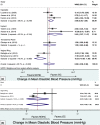The effect of non-oral hormonal contraceptives on hypertension and blood pressure: A systematic review and meta-analysis
- PMID: 35510324
- PMCID: PMC9069167
- DOI: 10.14814/phy2.15267
The effect of non-oral hormonal contraceptives on hypertension and blood pressure: A systematic review and meta-analysis
Abstract
Oral contraceptives (OC) are associated with increased risk of hypertension and elevated blood pressure (BP). Whether non-oral hormonal contraceptives have similar associations is unknown. We sought to investigate the effect of non-oral hormonal contraceptive (NOHC) use on the risk of hypertension and changes in BP, compared to non-hormonal contraceptive and OC use. We searched bibliographic databases (MEDLINE, EMBASE, Cochrane Central Register of Controlled Trials) until August 2020. Studies reporting risk of hypertension or changes in systolic and diastolic BP with NOHC use compared with either non-hormonal contraceptive or OC use. Abstract screening, full-text review, data extraction, and quality assessment were completed in duplicate. For studies reporting dichotomous outcomes, we reported results as relative risk with 95% confidence intervals (CI). A random-effects model was used to estimate pooled weighted mean difference and 95% CI of change in BP. Twenty-five studies were included. A lower incidence of hypertension was observed with injectable contraceptive use compared to non-hormonal contraceptive and OC use, although it was unclear if this was statistically significant. Compared to non-hormonal contraceptive use, injectable contraceptive use was associated with increased BP (SBP: 3.24 mmHg, 95%CI 2.49 to 3.98 mmHg; DBP: 3.15 mmHg, 95%CI 0.09 to 6.20 mmHg), the hormonal intra-uterine device use was associated with reduced BP (SBP: -4.50 mmHg, 95%CI -8.44 to -0.57 mmHg; DBP: -7.48 mmHg, 95% -14.90 to -0.05 mmHg), and the vaginal ring was associated with reduced diastolic BP (-3.90 mmHg, 95%CI -6.67 to -1.13 mmHg). Compared to OC use, the injectable contraceptive use was associated with increased diastolic BP (2.38 mmHg, 95%CI 0.39 to 4.38 mmHg). NOHC use is associated with changes in BP which differ by type and route of administration. Given the strong association between incremental increases in BP and cardiovascular risk, prospective studies are required.
© 2022 The Authors. Physiological Reports published by Wiley Periodicals LLC on behalf of The Physiological Society and the American Physiological Society.
Figures



Similar articles
-
Blood pressure changes and oral contraceptive use: a study of 2676 black women in the southeastern United States.Am J Epidemiol. 1980 Oct;112(4):539-52. doi: 10.1093/oxfordjournals.aje.a113023. Am J Epidemiol. 1980. PMID: 7424902
-
Oral contraceptives: a risk factor for uncontrolled blood pressure among hypertensive women.Contraception. 2003 Jan;67(1):19-24. doi: 10.1016/s0010-7824(02)00429-8. Contraception. 2003. PMID: 12521653
-
Stopping oral contraceptives: an effective blood pressure-lowering intervention in women with hypertension.J Hum Hypertens. 2005 Jun;19(6):451-5. doi: 10.1038/sj.jhh.1001841. J Hum Hypertens. 2005. PMID: 15759027
-
Steroidal contraceptives: effect on carbohydrate metabolism in women without diabetes mellitus.Cochrane Database Syst Rev. 2019 Nov 12;2019(11). doi: 10.1002/14651858.CD006133.pub5. Cochrane Database Syst Rev. 2019. PMID: 31711271
-
Effects of tea intake on blood pressure: a meta-analysis of randomised controlled trials.Br J Nutr. 2014 Oct 14;112(7):1043-54. doi: 10.1017/S0007114514001731. Epub 2014 Aug 19. Br J Nutr. 2014. PMID: 25137341 Review.
Cited by
-
Change of HeART: Cardiovascular Implications of Assisted Reproductive Technology.CJC Open. 2023 Sep 15;6(2Part B):142-152. doi: 10.1016/j.cjco.2023.09.008. eCollection 2024 Feb. CJC Open. 2023. PMID: 38487072 Free PMC article. Review.
-
Changes in Canadian contraceptive choices: results of a national survey on hormonal contraceptive use.BMC Womens Health. 2025 Mar 29;25(1):147. doi: 10.1186/s12905-025-03597-3. BMC Womens Health. 2025. PMID: 40155885 Free PMC article.
-
Contraception for All Conceivable Occasions: The CKD Care Gap.Kidney Med. 2023 Nov 18;5(12):100747. doi: 10.1016/j.xkme.2023.100747. eCollection 2023 Dec. Kidney Med. 2023. PMID: 38077695 Free PMC article. No abstract available.
-
Hormonal contraceptive use among women living with hypertension in sub-Saharan Africa: insights from 12 countries.BMC Res Notes. 2024 Jun 19;17(1):167. doi: 10.1186/s13104-024-06830-8. BMC Res Notes. 2024. PMID: 38898484 Free PMC article.
-
Moderate Associations Between the Use of Levonorgestrel-releasing Intrauterine Device and Metabolomics Profile.J Clin Endocrinol Metab. 2025 Mar 17;110(4):e1134-e1148. doi: 10.1210/clinem/dgae318. J Clin Endocrinol Metab. 2025. PMID: 38717898 Free PMC article.
References
-
- Al‐Obaidy, M. J. , & Al‐Youzbaki, W. B. (2014). Evaluation of the effect of depot medroxyprogesterone acetate injections as contraceptives on some coagulation paramters. Journal of Pharmacy Research, 8(8), 1022–1026.
-
- Asare, G. A. , Santa, S. , Ngala, R. A. , Asiedu, B. , Afriyie, D. , & Amoah, A. G. (2014). Effect of hormonal contraceptives on lipid profile and the risk indices for cardiovascular disease in a Ghanaian community. International Journal of Women's Health, 6, 597–603. 10.2147/IJWH.S59852 - DOI - PMC - PubMed
-
- Avila, W. S. , Grinberg, M. , Melo, N. R. , Aristodemo Pinotti, J. , & Pileggi, F. (1996). Contraceptive use in women with heart disease. Arquivos Brasileiros De Cardiologia. 66(4), 205–211. Uso de contraceptivos em portadoras de cardiopatia. - PubMed
Publication types
MeSH terms
Substances
LinkOut - more resources
Full Text Sources
Medical

